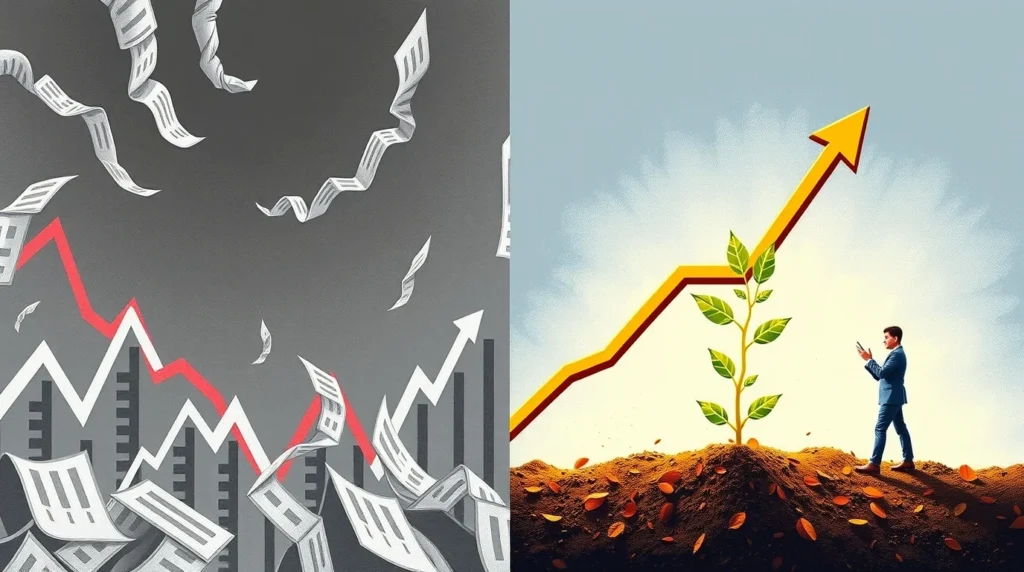Table of Contents
Introduction – US Stock Market Crash
US Stock Market Crash – 📉 Panic. Fear. Uncertainty. These are the emotions that often grip investors during a stock market crash. But what if we told you that a market downturn could be your ticket to financial prosperity? 🚀💰
Contrary to popular belief, a US stock market crash isn’t just a time of economic turmoil—it’s a golden opportunity waiting to be seized. While others are selling in fear, savvy investors are gearing up to build lasting wealth. But how exactly can you turn this financial chaos into your personal jackpot?
In this blog post, we’ll dive deep into the world of market crashes and reveal why they might be your best chance to accelerate your wealth-building journey. From understanding the anatomy of a market downturn to exploring lucrative strategies and key sectors to watch, we’ll equip you with the knowledge and tools you need to navigate these turbulent waters with confidence. So, buckle up and get ready to transform your financial future—because in the world of investing, sometimes the biggest opportunities come disguised as challenges. 🎭💼
Understanding Market Crashes
A. Definition and historical context
A stock market crash is a sudden, dramatic decline in stock prices across a significant cross-section of a stock market. Historically, crashes have occurred periodically, with notable examples including the Great Depression of 1929 and the 2008 Financial Crisis. These events are often characterized by:
- Rapid price declines (typically 20% or more)
- Widespread panic selling
- Significant economic impact
- US Stock Market Crash
Here’s a brief overview of major US stock market crashes:
| Year | Event | Decline |
|---|---|---|
| 1929 | Great Depression | 89% |
| 1987 | Black Monday | 22% |
| 2000 | Dot-com Bubble | 49% |
| 2008 | Financial Crisis | 54% |
B. Causes of the current US stock market crash
The current market downturn can be attributed to several factors:
- Economic uncertainty due to global events
- Inflation concerns and rising interest rates
- Overvaluation of certain sectors, particularly tech stocks
- Geopolitical tensions and trade disputes
- US Stock Market Crash
C. Impact on different sectors
Market crashes affect various sectors differently. In the current scenario:
- Technology: Often hit hard due to high valuations
- Healthcare: Generally more resilient, but not immune
- Energy: Fluctuates based on global demand and supply dynamics
- Finance: Affected by interest rate changes and economic outlook
- US Stock Market Crash
Understanding these sector-specific impacts is crucial for identifying potential opportunities in a downturn. As we move forward, we’ll explore how savvy investors can leverage these market conditions to their advantage.

The Silver Lining: Opportunities in a Downturn
Lower stock prices for quality companies
During a market downturn, high-quality companies often experience significant price drops, presenting an excellent opportunity for savvy investors. This “buy the dip” strategy allows you to acquire shares of well-established businesses at discounted rates.
| Company Type | Advantages | Considerations |
|---|---|---|
| Blue-chip stocks | Stable financials, proven track record | May recover slower |
| Growth stocks | High potential for future gains | Higher volatility |
| Value stocks | Undervalued, potential for price correction | Requires patience |
Increased dividend yields
As stock prices fall, dividend yields naturally increase, making income-focused investing more attractive. Consider these benefits:
- Higher passive income potential
- Compounding effect through dividend reinvestment
- Cushion against market volatility
- US Stock Market Crash
Potential for long-term growth
Market crashes often lead to overselling, creating opportunities for substantial long-term gains. Key points to remember:
- Historical data shows markets tend to recover and surpass previous highs
- Patient investors can benefit from price appreciation
- Dollar-cost averaging can maximize returns during recovery periods
- US Stock Market Crash
Diversification opportunities
Downturns provide a chance to rebalance and diversify your portfolio:
- Explore undervalued sectors or industries
- Consider safe-haven assets like gold for added stability
- Investigate emerging markets for potential growth
- US Stock Market Crash
By capitalizing on these opportunities, investors can position themselves for future wealth accumulation as the market recovers and grows.

Strategies for Building Wealth During a Crash
A. Dollar-cost averaging
Dollar-cost averaging (DCA) is a powerful strategy for building wealth during a market crash. This approach involves consistently investing a fixed amount of money at regular intervals, regardless of market conditions. By doing so, you buy more shares when prices are low and fewer shares when prices are high, potentially lowering your average cost per share over time.
Benefits of dollar-cost averaging:
- Reduces timing risk
- Minimizes emotional decision-making
- Capitalizes on market volatility
- US Stock Market Crash
| Scenario | Lump Sum Investment | Dollar-Cost Averaging |
|---|---|---|
| Bull Market | Potentially higher returns | Steady growth |
| Bear Market | Higher risk of losses | Mitigated losses |
B. Value investing principles
Value investing focuses on identifying undervalued stocks with strong fundamentals. During a market crash, many quality companies may be trading at discounted prices, presenting excellent opportunities for long-term investors.
Key value investing metrics:
- Price-to-earnings (P/E) ratio
- Price-to-book (P/B) ratio
- Debt-to-equity ratio
- Free cash flow
- US Stock Market Crash
C. Focusing on fundamentally strong companies
In times of market turmoil, it’s crucial to invest in companies with solid fundamentals. These businesses are more likely to weather economic storms and emerge stronger on the other side.
Characteristics of fundamentally strong companies:
- Consistent revenue growth
- Strong balance sheet
- Competitive advantages
- Experienced management team
- US Stock Market Crash
D. Exploring defensive sectors
Defensive sectors tend to perform better during economic downturns, offering stability and potential growth opportunities. These sectors typically provide essential goods and services that remain in demand regardless of economic conditions.
Examples of defensive sectors:
- Consumer staples
- Healthcare
- Utilities
- Telecommunications
- US Stock Market Crash
E. Considering index funds and ETFs
Index funds and ETFs offer broad market exposure and diversification, which can help mitigate risk during a market crash. These investment vehicles allow you to invest in a basket of stocks or other assets, spreading your risk across multiple companies or sectors.
Now that we’ve explored various strategies for building wealth during a market crash, let’s examine how to manage risk in volatile markets.

Managing Risk in Volatile Markets
Importance of emergency funds
In volatile markets, having a robust emergency fund is crucial. It acts as a financial buffer, allowing you to weather market downturns without being forced to sell investments at inopportune times.
- Ideal emergency fund size: 3-6 months of living expenses
- Keep in easily accessible, low-risk accounts
- Prevents panic selling during market dips
- US Stock Market Crash
Balancing your portfolio
A well-balanced portfolio is key to managing risk during market volatility. Diversification across different asset classes can help mitigate losses and capture potential gains.
| Asset Class | Risk Level | Potential Return |
|---|---|---|
| Stocks | High | High |
| Bonds | Medium | Medium |
| Cash | Low | Low |
| Real Estate | Medium | Medium-High |
Setting realistic expectations
Understanding market cycles and setting realistic expectations can help you stay calm during turbulent times. Remember:
- Markets are cyclical
- Short-term volatility is normal
- Long-term trends tend to be positive
- US Stock Market Crash
Avoiding emotional decision-making
Emotional reactions to market swings can lead to poor investment choices. To avoid this:
- Stick to your investment plan
- Avoid constantly checking your portfolio
- Consider automated investing strategies like dollar-cost averaging
- US Stock Market Crash
By implementing these risk management strategies, you’ll be better equipped to navigate volatile markets and potentially turn market downturns into opportunities for long-term wealth building. Next, we’ll explore why market crashes can actually be beneficial from a long-term perspective.

Long-term Perspective: Why Crashes Can Be Beneficial
Historical market recovery patterns
Market crashes, while initially alarming, have historically demonstrated consistent recovery patterns. Let’s examine the data:
| Crash Year | Downturn % | Recovery Time (Years) |
|---|---|---|
| 1929 | -86% | 25 |
| 1987 | -34% | 2 |
| 2000 | -49% | 7 |
| 2008 | -57% | 4 |
| 2020 | -34% | <1 |
As we can see, markets have always rebounded, often stronger than before. This resilience underscores the importance of long-term investing strategies.
Compound interest advantages
During market downturns, the power of compound interest becomes even more pronounced. By consistently investing through crashes, you can:
- Accumulate more shares at lower prices
- Benefit from higher dividend yields
- Amplify returns when the market recovers
- US Stock Market Crash
Building wealth through economic cycles
Economic cycles present unique opportunities for wealth creation:
- Recessions: Ideal for acquiring undervalued assets
- Recoveries: Capitalize on rapid growth and appreciation
- Expansions: Benefit from overall market gains
- US Stock Market Crash
By maintaining a long-term perspective and strategically investing across these cycles, you can build substantial wealth over time. Remember, successful investors like Warren Buffett often view market crashes as opportunities to “be greedy when others are fearful.”

Key Sectors and Industries to Watch
A. Technology and innovation
In times of market volatility, technology and innovation sectors often present unique opportunities for wealth building. These industries are known for their resilience and potential for rapid growth, even during economic downturns.
Key areas to watch include:
- Artificial Intelligence (AI) and Machine Learning
- Cloud Computing
- Cybersecurity
- 5G Technology
- Internet of Things (IoT)
- US Stock Market Crash
| Industry | Potential Opportunities | Risks |
|---|---|---|
| AI/ML | Automation, Data Analytics | Regulatory challenges |
| Cloud Computing | Remote work solutions, Data storage | Data privacy concerns |
| Cybersecurity | Increased demand for digital protection | Evolving threat landscape |
| 5G | Enhanced connectivity, IoT expansion | High infrastructure costs |
B. Healthcare and biotech
The healthcare and biotech sectors have shown remarkable resilience during market downturns, often outperforming other industries. These sectors benefit from constant demand and ongoing innovation.
Areas of focus include:
- Telemedicine
- Genomics and personalized medicine
- Medical devices
- Pharmaceutical research
- US Stock Market Crash
C. Green energy and sustainability
As the world shifts towards sustainable practices, the green energy sector presents significant growth potential. Key areas include:
- Solar and wind energy
- Electric vehicles and battery technology
- Smart grid solutions
- Waste management and recycling technologies
- US Stock Market Crash
D. E-commerce and digital transformation
The e-commerce sector has experienced exponential growth, accelerated by recent global events. Companies driving digital transformation across various industries are likely to thrive. Watch for:
- Online retail platforms
- Digital payment solutions
- Cloud-based business software
- Augmented and Virtual Reality technologies
- US Stock Market Crash
As we explore these key sectors, it’s crucial to remember that proper risk management and diversification are essential in any investment strategy.

Tools and Resources for Informed Investing
Financial news and analysis platforms
In today’s fast-paced market, staying informed is crucial. Financial news and analysis platforms provide real-time updates and expert insights. Some popular options include:
- Bloomberg Terminal
- Reuters
- CNBC
- Financial Times
- MarketWatch
- US Stock Market Crash
These platforms offer a mix of breaking news, in-depth analysis, and market data to help you make informed decisions during volatile times.
Stock screening tools
Stock screening tools are invaluable for identifying potential investment opportunities. They allow you to filter stocks based on various criteria, such as:
| Criteria | Examples |
|---|---|
| Financial ratios | P/E ratio, Debt-to-Equity |
| Technical indicators | Moving averages, RSI |
| Fundamental factors | Dividend yield, Market cap |
Popular stock screening tools include Finviz, Yahoo Finance, and TradingView.
Professional advice and wealth management services
For those seeking personalized guidance, professional advice can be invaluable. Options include:
- Robo-advisors (e.g., Betterment, Wealthfront)
- Traditional financial advisors
- Wealth management firms
- US Stock Market Crash
These services can help tailor investment strategies to your specific goals and risk tolerance.
Educational resources for self-directed investors
Empowering yourself with knowledge is key to successful investing. Consider these resources:
- Online courses (Coursera, edX)
- Investment books (e.g., “The Intelligent Investor” by Benjamin Graham)
- Podcasts (e.g., “Motley Fool Money,” “InvestED”)
- YouTube channels (e.g., “The Plain Bagel,” “Aswath Damodaran”)
- US Stock Market Crash
By leveraging these tools and resources, you’ll be better equipped to navigate market volatility and capitalize on potential opportunities during a stock market crash.
Conclusion
Market crashes, while intimidating, can present unique opportunities for savvy investors to build long-term wealth. By understanding the dynamics of market downturns and implementing strategic investment approaches, you can position yourself to capitalize on undervalued assets and potentially achieve significant returns when the market recovers. Remember to manage risk carefully, maintain a long-term perspective, and stay informed about key sectors and industry trends.
As you navigate these turbulent times, consider this market crash not as a setback, but as a stepping stone towards financial growth. Equip yourself with the right tools, resources, and knowledge to make informed investment decisions. With patience, discipline, and a well-thought-out strategy, you can transform this challenging period into a golden opportunity to build lasting wealth and achieve your financial goals.
Frequently Asked Questions (FAQs) About US Stock Market Crash
What exactly is a stock market crash?
A crash is a sudden, steep decline—usually 20% or more—in broad market indices over a short period. Crashes are often driven by panic selling, shifts in economic outlook, or external shocks.
Why can a market crash be a good time to invest?
During crashes, share prices of fundamentally strong companies fall, letting you “buy the dip” at discounted valuations. Over the long run, markets historically recover and exceed prior highs.
How do I know which companies are “fundamentally strong”?
Look for businesses with:
– Consistent revenue and earnings growth
– Low debt-to‑equity ratios
– Healthy free cash flow
– Competitive advantages (brands, patents, network effects)
What is dollar‑cost averaging (DCA)?
DCA means investing a fixed dollar amount at regular intervals (e.g., monthly), regardless of price. This smooths out purchase prices—buying more when prices are low and fewer when they’re high.
How does value investing fit into a crash?
Value investors hunt for stocks trading below intrinsic worth, using metrics like low P/E or P/B ratios. Crashes often push even quality names into “value territory.”
Which sectors tend to be more defensive during downturns?
Defensive sectors supply essentials that remain in demand:
– Consumer staples (food, household goods)
– Healthcare (pharma, medical services)
– Utilities (electricity, water)
– Telecommunications
Should I sell or hold my current investments when the market plunges?
Panic selling locks in losses. Instead, review your plan: if your holdings remain fundamentally sound and aligned with your goals, holding (or adding) is often wiser.
How long does it typically take for the market to recover?
Recovery times vary:
– Black Monday (1987): ~2 years
– Dot‑com bust (2000): ~7 years
– Global Financial Crisis (2008): ~4 years
– COVID‑19 crash (2020): <1 year
What role do index funds and ETFs play in a crash?
Broad-market ETFs and index funds offer instant diversification across hundreds (or thousands) of stocks, reducing single‑stock risk and smoothing volatility.
How much cash should I keep on hand during volatile times?
Aim for an emergency fund covering 3–6 months of living expenses in a liquid, low‑risk account to avoid forced selling at market bottoms.
What’s the importance of portfolio diversification?
Spreading assets—stocks, bonds, cash, real estate—limits the impact if any one asset class or sector suffers a downturn.
How can I avoid emotional investing mistakes?
– Stick to a written plan
– Automate contributions (DCA)
– Limit how often you check performance
– Remind yourself of historical recoveries
What key financial ratios help in crash‑time stock selection?
– P/E ratio (price-to-earnings)
– P/B ratio (price-to-book)
– Debt-to-equity
– Free cash flow yield
Are there special strategies for dividend investors?
Falling prices boost dividend yields. Reinvested dividends compound returns, and reliable dividend-payers often weather downturns better.
When should I rebalance my portfolio during a downturn?
Rebalance when your actual allocations deviate meaningfully (e.g., by 5–10%) from targets, selling overweight assets and buying underweight ones.
What emerging themes could outperform after a crash?
– Artificial Intelligence & Cloud
– Healthcare innovations (telemedicine, genomics)
– Green energy (solar, EVs, smart grids)
– E‑commerce and digital payments
Which tools can help me stay informed and spot opportunities?
– News platforms: Bloomberg, Reuters, CNBC
– Screeners: Finviz, Yahoo Finance, TradingView
– Research: SEC filings, analyst reports
How do I use stock screeners effectively in a crash?
Filter for low valuations (P/E, P/B), strong balance sheets (low debt), positive cash flow, and dividend yields—then cross‑check qualitative factors.
Is timing the market a viable crash strategy?
Market timing is extremely difficult and risky. A systematic approach (DCA, value hunting) typically outperforms attempts to predict exact bottoms or tops.
What mindset should I adopt to build wealth through cycles?
Embrace a long‑term perspective: view crashes as opportunities, focus on fundamentals, maintain discipline, and remember that patience has historically been rewarded in equity markets.




Pingback: How to Create a Monthly Budget: 5 Powerful Strategies for Smart Spending 🔥💡 - SuperWebTools
Pingback: Powerful AI Tools for Creating and Selling Online Courses 2025 - Passive Profit
Pingback: Incredible Opportunities: Can I Buy Shares In Deepseek & Invest Smartly 2025? 🌠💼 - Super Lab